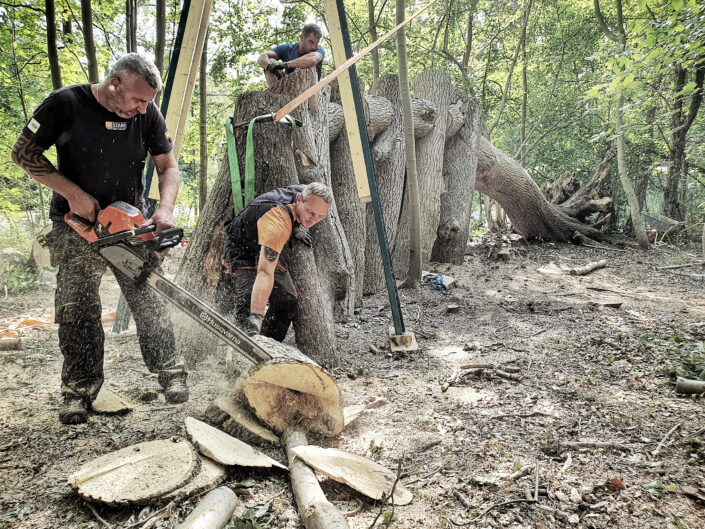2022 Sea Creature
Project: www.17goalsonmymind.com
Anneberg Sculpture Park, Denmark
Medium: Wood
Size: 12.4m long X 3.5m wide X 3.2m high
SDG#9: Innovation/Industry/Infrastructure
The Sea Creature 2022, took form as the Sustainability Development Goal #9. The work comments on how industry cuts natural material such as wood into straight planks to build cities in grids, and therefor downgrading the tree’s original architecture. This artwork stays rooted to the ground where the 130-year-old Ash tree recently fell after slowly growing patiently through the manmade industrial revolution. The connection of the artwork to the earth and the forest systems can be observed in the works’ slow natural decay to learn how nature grows and recycle and reincorporating old established techniques to consider healthier ways forward. The Ash tree fell near a lake, probably during the storm on 29 January 2022 according to geopark geologist, Jakob Walløe Hansen. Lakes and swamp holes like this formed in many places during the ending of the latest ice age, thereby drawing attention to how the landscape changes over time – often due to climate change.
This artwork is based on recent research of an ancient fossil called the Tamisiocaris borealis. This free-swimming suspension-feeder swept the ocean floor whilst stimulating diverse evolution of species 520 million years ago. As a planktivore it fed on tiny particles by filtering water through a gaping mouth, similar to how whales feed today. What is surprising is that even though they were large in scale and at the top of the food chain, they were not predatory as have previously been assumed (Daley and Peel, 2010). With mouths wide open they filter food with long combs the way fishing nets catch fish. I wonder how we can learn from these creatures to filter out all the microplastics and nets we have left in the ocean since the 1950’s.
To build the fallen tree sculpture I turned the forks of the tree upside down for the Sea Creature’s ‘legs’ or ‘combs’, deconstructing and reconstructing smashed branches from the fall, restacked, and built with gravity and interlocking log cabin joins. Traditional log cabin carpentry techniques celebrate and acknowledge natural lines and inherent architectural strength in nature. Professional craftsmen from the cultural park’s carpentry workshop, equipped with chainsaws, chain blocks and a sailboat ratchet, built the artwork in seven consecutive ten-hour days under my direction. Working without large machines we had to reconsider gravity, safety, and balance during the construction process. Not using mechanical equipment leaves a lighter impact on the forest floor. Keeping the root system attached to the forest floor at the sculptures gaping open mouth keep the intervention in nature ecologically connected to the earth, inviting forest fauna and flora to slowly recycle the tree back into the soil. The Sea Creature’s legs are placed directly on the soil to create an insect friendly sculpture with access for the forest to claim the sculpture back over the decades to come.
On the last day of construction, an oyster hat mushroom popped up overnight on the neck of the creature. Local mushroom expert, Jørgen Stoltz, still needs to be confirm if it is edible. The craftsmen also spotted hatchlings in one of the logs and we left them undisturbed.
Hooks could be attached to the sculpture to invite participation in this conversation to discuss wicked problems humans have caused. Old Viking methods such as making rope with waste wool from local farmers could be conversation starters. The artist invites visitors to think about ways of combing the ocean to take microplastics our industries have left in the ocean, killing many species including whales and turtles.
Visitors are welcome to respond to the artist with co-designing ideas to solve the wicked problems we have caused via Instagram DM @hanneliecoetzee. More questions are left open for conversation. Why did the Ash Tree fall in the first place? If we learn to interfere with nature more mindfully, can we build a co-existence with nature in the future?
Thank you to amazing teams who made this project a sculpture-park in a kultur-park in a geo-park: Pia Johansen from www.kunstkollektivet8B.dk for conceptualisation and persistence of www.17goalsonmymind.com, including a wonderful residency with fellow artists. Gitte Klausen, Anneberg Kulturpark and her team for enabling resources and making the grounds available to these new artworks. A special thank you to the professional carpentry team: Sandijs Bauers, Andrejs Krūmiņš and Jānis Pētersons, who built this artwork from scratch in 7 days. Nothing was impossible on a super tight budget.
The Tamisiocaris borealis fossil the artwork is based on:
Tamisiocaris borealis n. gen and n. sp. 1, Holotype MGUH 29154 part; light from upper right; 2, camera lucida drawing of holotype, part; 3, holotype counterpart, showing surface fabric; light from upper left; 4, holotype, part, with complete ventral spines exposed by preparation; light from bottom right; 5, holotype, part, showing distorted ventral spine; light from upper right. Scale bars 1–2, 10 mm; 3–5, 5 mm. Abbreviations: c, carapace; d, possible dorsal spine; t, termination of appendage; v, ventral spine. (Daley and Peel, 2010)








